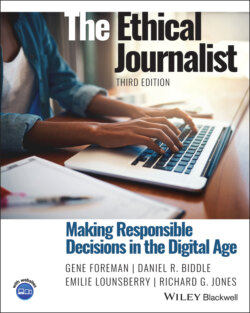Читать книгу The Ethical Journalist - Gene Foreman - Страница 11
ОглавлениеPreface
By Gene Foreman
I am pleased to present this thoroughly updated third edition of The Ethical Journalist and to welcome three esteemed former colleagues as coauthors: Daniel R. Biddle, Emilie Lounsberry, and Richard G. Jones. All of us have worked at The Philadelphia Inquirer, and all of us have taught journalism at the college level.
Our book is intended to inform your professional life. Technically, it is published as a textbook for college courses in journalism ethics and communications ethics, and as the ethics textbook in a course combining journalism ethics and law. We hope that practicing journalists will also find it useful for its comprehensive discussion of the standards of the profession.
If you fit those categories of student journalist or practicing journalist, you will find yourself addressed directly in this book. We reach out to you in two ways: first, to help you learn to make ethically defensible decisions in the practice of journalism; and, second, to give you the benefit of the thinking of generations of professionals and scholars that resulted in today’s consensus guidelines for ethical conduct.
With these goals in mind, we have divided the book into two parts. Part I examines ethics in a general way, explains the importance of ethics to journalism, and outlines a decision‐making strategy. Part II discusses subject areas in which journalists frequently confront ethics questions, and it offers real-life case studies in which you can decide how to respond to the ethics challenges that the actual journalists faced.
Throughout the book, the consensus guidelines are explained, not to dictate your decision‐making but to offer a starting point for thinking through the issues. The idea is that you don’t have to start from a zero base; you can build on the best thinking of those who have gone before. Where there is disagreement in the profession, we have noted that, too. In several instances we advocate for what we consider to be the best practice.
Teachers who have used previous editions of The Ethical Journalist will notice a modest restructuring. Recognizing Donald Trump’s profound influence on the practice of journalism, we have devoted an entire chapter in Part I to “the Trump effect.” In Part II, each of the first four chapters is devoted to an in-depth discussion of a guiding principle of the Society of Professional Journalists ethics code, and we have added a chapter on journalists’ use of social media. Finally, the chapters on journalist misconduct and “the business of journalism” have been moved to the end of the book, not to minimize their importance but to separate them from the Part II chapters focusing on practical ethics issues.
The book reflects the coauthors’ experience in the practice of journalism. It is important to note, however, that we have also been influenced by ethics scholars. We have benefited from the scholars’ thoughtful analysis of issues whose nuances we practicing journalists sometimes overlooked as we focused on the next deadline.
To learn journalistic techniques like writing headlines for a website, we presume that you will take other courses and read other textbooks. In contrast, the purpose of this book is to encourage you to ponder the ethics ramifications of what journalists do, whether the consumer gets the news from a computer or a mobile device or a newspaper or a TV or a radio.
The case studies and other actual experiences of journalists recounted in this book illustrate ethics choices you may have to make. In selecting the case studies, we applied an essential yardstick: whether the case illustrates an ethics issue that might be encountered by a journalist in the digital age. The cases reflect episodes that occurred on all news platforms – digital, broadcast, and print. Most of them occurred in recent years, but a few were earlier. For today’s journalists, all of them are pertinent.
The journalists’ decisions in the book’s examples are open to debate, which is precisely why you should study them. If you decide that the journalists involved in case studies made a mistake, bear in mind that, nearly always, those were mistakes of the head and not of the heart. In many ways, learning journalism ethics is about learning from our mistakes.
Our online resources
This book is accompanied by two websites that allow readers to continue to explore issues in journalism ethics.
For instructors who are using the book in their courses, there is a password-protected Instructor Companion Site offering sample slideshow presentations, quiz templates, and other materials for use in the classroom. This site can be reached by visiting www.wiley.com/go/foreman/theethicaljournalist3e.
For all users of the book, the authors have created an Online Forum featuring news updates, videos, supplemental readings, and a comments section for continued discussion. The Online Forum can be accessed at theethicaljournalist.com. The forum is regularly updated by the authors; it is not managed by Wiley-Blackwell, nor is its content published, pre-screened, or pre-approved by the publishing company.
Gene Foreman April 2022
